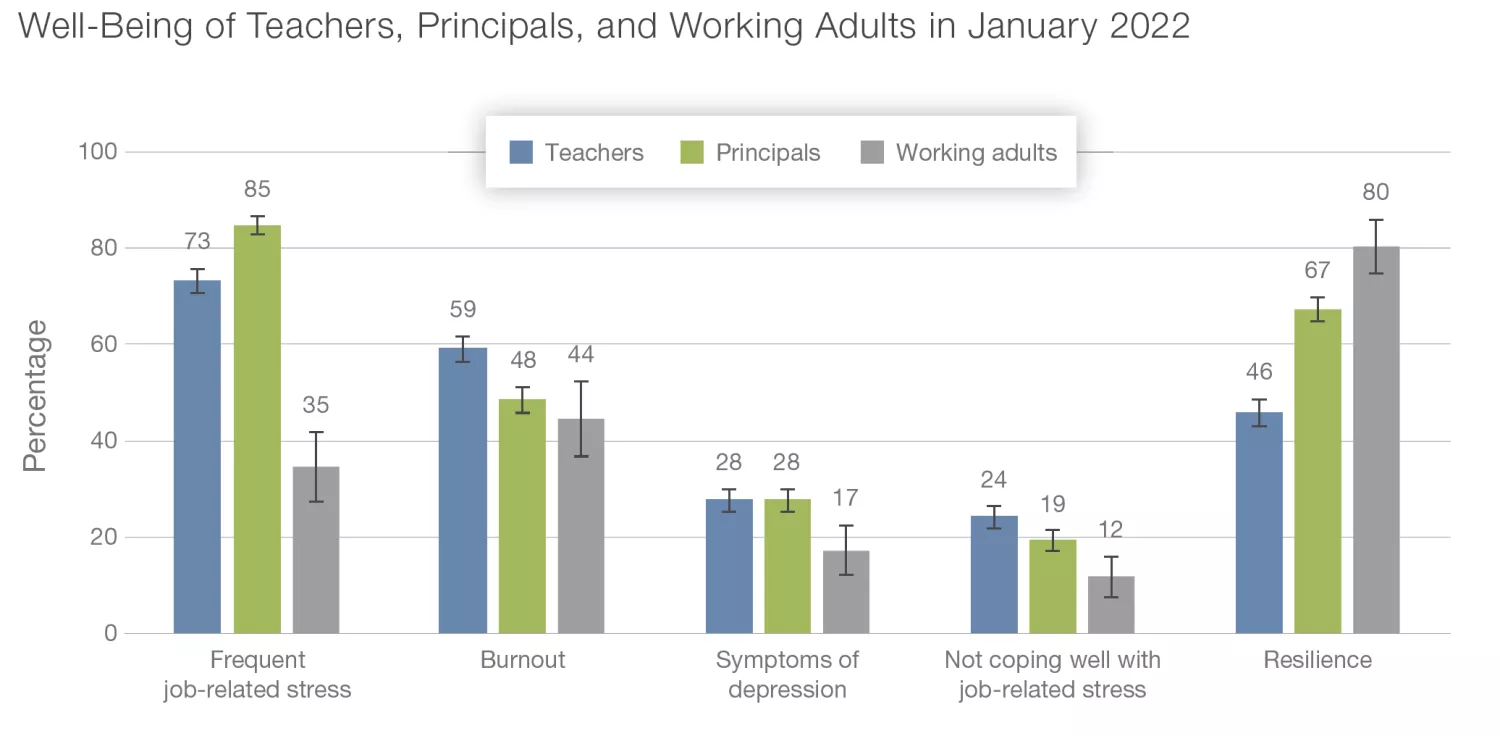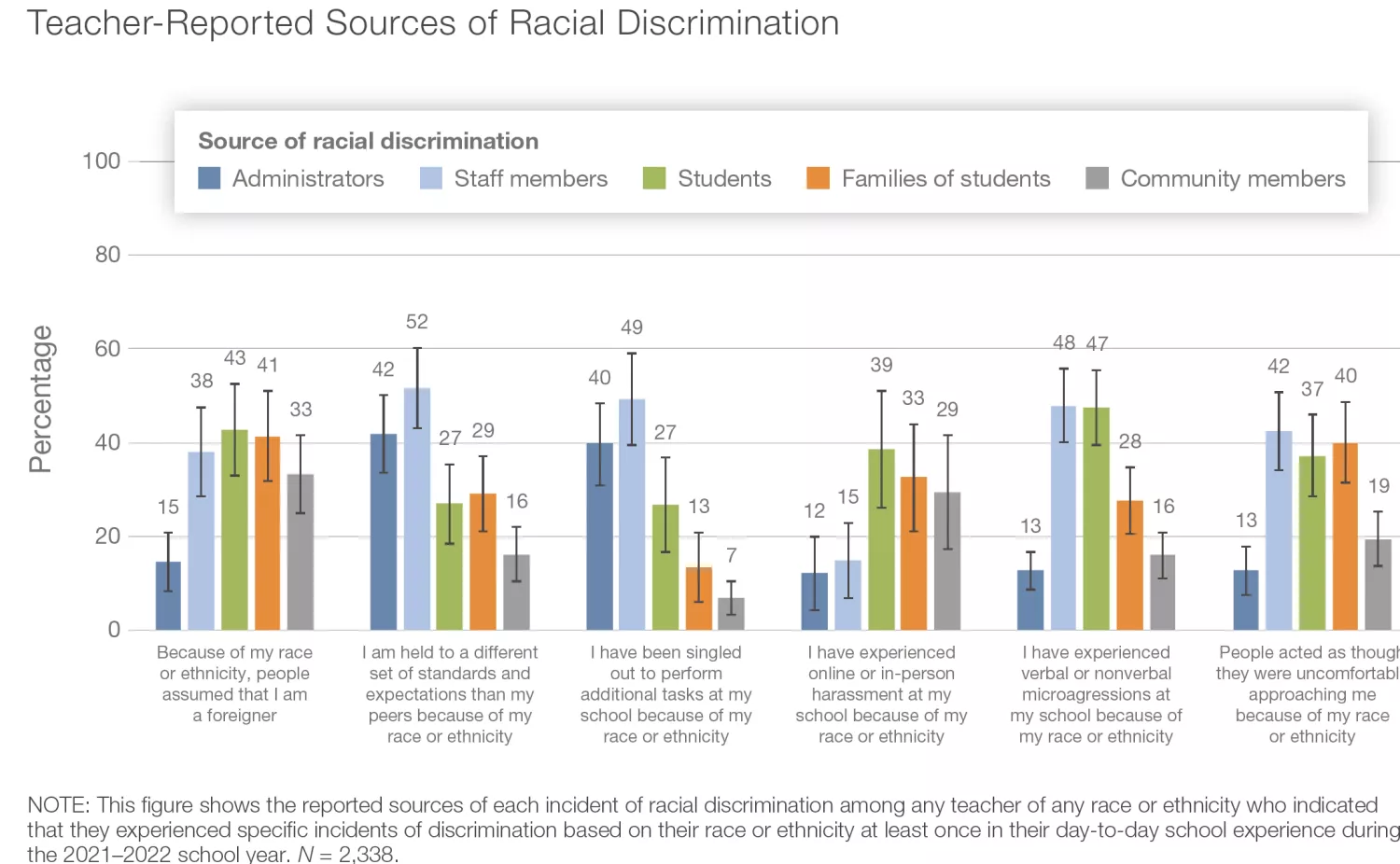
Key Takeaways
- The RAND report found that well-being is especially poor among Hispanic/Latinx teachers, mid-career teachers and female teachers.
- Poor well-being and adverse working conditions were linked with educators' intentions to leave their jobs.
- To create more supportive environments for educators, district and school leaders should avoid superficial, one-off wellness programs and take a system-wide, comprehensive approach.
Educator shortages across the nation this past year pushed too many school districts to the brink. As schools struggled and failed to fill key positions, educator workloads, always heavy, became almost overwhelming.
"Teaching never stops," says Samantha Twohig, a special education teacher in West Virginia. "I don’t recall the last time I got a full lunch break — without behavior check-ins, a parent phone call, or the extra coverage needed due to lack of subs. Instead of planning periods. When the bell rings at 3:30, and students go home, my grading and planning work is far from finished."
As another challenging and exhausting school year grows to a close, a mass teacher exodus looms on the horizon. Districts and school leaders better move fast because, according to a new RAND Corporation survey, teachers and principals are experiencing job-related stress at a rate about twice that of the general population of working adults. Not surprisingly, both teachers and principals cited poor-well-being and adverse working conditions as factors in their stated intention to leave their jobs.
The RAND report uses data from the annual State of the American Teacher (funded in part by the National Education Association) and State of the American Principal Survey to examine the state of educator well-being, specifically looking at job-related stress, burnout, symptoms of depression, coping, and resilience. RAND also interviewed a nationally representative sample of working adults.
While the survey results are sobering, the report lays out a roadmap for districts to get serious about addressing the sources of teacher stress and strengthening the profession in the long-term.
"Improved well-being could bolster job satisfaction and engagement and help retain educators of all backgrounds in the profession," the authors write. "Improving the reputation of the teaching and principal professions might be an important lever for attracting a diverse group of future educators to the profession."

The State of Teacher Well-Being
Regardless of the specific measure, teachers are more likely to experience poor well-being than other working adults. Fifty-nine percent of teachers experienced burnout, compared to 48% of other working adults.
A Gallup survey, also released this week, reported similar results. Gallup found that 44% of K-12 workers felt burned out "very often or always," compared to 30% of all other workers.
The RAND survey also found that compared to their colleagues with 20 or more years of classroom experience, mid-career teachers were more likely to report symptoms of depression, frequent job-related stress, feeling less resilient, and less able to cope. And female teachers were more likely to report experiencing stress and less likely to report feeling resilient than their male counterparts.
Looking at the sources of stress for teachers, the RAND survey underscores the enormous impact teaching during COVID has had on the profession. Almost half the teachers surveyed cited supporting student learning during the pandemic. Around 30% of respondents pointed to managing student behavior and taking on extra work due to staff shortages. Twenty-three percent of teachers also cited working too many hours and low pay. Staffing has been a top source of stress for principals.
“When they cannot find someone [to substitute] . . . we have to take those students into our classes. That is very stressful.” - Teacher interviewed by RAND
Sources of stress were fairly uniform for educators, except for one key factor: Teachers of color and principals of color are more likely to experience racial discrimination.
The survey found that 36 percent of teachers of color (44 percent of Black teachers, 30 percent of Hispanic/Latinx teachers, 46 percent of API teachers) experienced at least one incident of racial discrimination in the 20201-22 school year. Forty-three percent of teachers exposed to discrimination reported symptoms of depression, compared with 25 percent of their peers who had not experienced any incidents.

The Decision to Leave the Profession
Racial discrimination could be a key reason why teachers of color are more likely to leave the profession than white teachers. The RAND survey found that forty-one percent of teachers of color reported that they intended to leave their jobs before the end of the 2021–2022 school year, compared with 31 percent of White teachers. Overall, one-third of teachers reported their intention to leave the profession in 2022.
Dissatisfaction with pandemic-era working conditions has taken a significant toll on the workforce. More than half the teachers interviewed by RAND attributed their dissatisfaction with their jobs and their desire to leave to factors that have been more prevalent since the pandemic.
“We’re not paid what we’re worth. . . . No one wants to go into this profession because the pay is terrible and the demands are way too much.” - Teacher interviewed by RAND
In 2020-21, school districts saw a disturbing increase in harassment and threats over COVID mitigation measures and, later, classroom curriculum. These trends, along with incidents of school violence, were also strongly linked to the intention to leave the profession
The study notes that burnout and racial discrimination are also predictive of this decision, but both have been factors long before 2020.
Needed: System-Wide Strategies
So how do educators cope? Not surprisingly, they depend on one another. The RAND survey found that most teachers find social support from colleagues, family members, and friends. They also prioritize self-defined boundaries for work-life balance and self-care activities.
These approaches are always helpful, but school districts have a greater responsibility to address and improve educator well-being.
The survey findings suggest that access to employer-provided mental health supports is linked to lower levels of job-related stress and higher levels of resilience for teachers. About 35% of teachers, however, reported that they did not have access to these supports or did not know whether they were available.
For those educators that did have access, reviews were at best mixed. According to the study, relatively few teachers consider those services valuable or useful. Among other issues, teachers generally did not have confidence that the supports were anonymous or confidential or they did not consider the services particularly relevant to their needs.
The report's authors urge district leaders to "avoid the appearance of treating wellness as a superficial or short-term problem and offer mental health and well-being supports tailored to educators’ needs.”
“They offer things like wellness programs and mindfulness activities . . . those things are not helpful.. . . They were adding things to my plate just to check a box.” - Teacher interviewed by RAND
Districts need to ramp up efforts to fill staff shortages in the short-term but also implement new strategies to keep the educator pipeline flowing. The authors call attention to "Grow Your Own" programs as a promising avenue. NEA Great Public School grants have funded these programs in California, Connecticut, Florida, Nebraska, North Carolina and elsewhere.
Despite the enormous challenges facing educators, the RAND survey also found that many educators believed they were coping well. One half of teachers said they were able to find the necessary resilience to manage stress.
And they continue to find joy in their work.
“Teachers told us that their dedication to working with students kept them in their jobs, even though pandemic conditions have made teaching more challenging," explains Elizabeth Steiner, lead author of the report. "Teaching conditions – not the work of teaching itself – are what they find to be stressful.”
Learn More






